Cerebro is a sleek WordPress theme built for bloggers. This responsive, free theme will allow your site visitors to focus on what matters the most–your content.
Learn how you can get the most out of the theme with the Cerebro WordPress theme documentation.
Cerebro WordPress theme documentation, step 1: Theme specifications
- Recommended logo size: 220x50px.
- Featured image max width is 800px.
- Single post and page content width: 800px.
Cerebro WordPress theme documentation, step 2: Theme installation
The theme can be installed through the WordPress Admin panel.
- Log in to the WordPress Admin panel.
- Go to Appearance -> Themes.
- Click on the Add New button, at the top of the screen.
- In Add Themes screen, click on Upload Theme.
- Click on Choose theme, and then browse for theme file on your computer.
- Click on Install Now to start the install process.
- After the installation is done, click on Activate theme.
A detailed video for theme installation is available here: https://help.themeskingdom.com/how-to-install-and-setup-the-theme.
After activating the theme, you will be prompted to install the required plugins. Required plugins in the Cerebro WordPress theme documentation are:
Cerebro WordPress theme documentation, step 3: Theme setup
Cerebro theme is set to display posts on the homepage using Blog page template. To set your theme the same way we did in the demo, be sure to follow these steps:
- First, you will need to create several post categories. Categories will be used to group posts.
- When you are done with creating the categories, create several posts and associate them with different categories. Make sure to set the featured image for each post. Add tags to your posts.
- Now, you’ll need to create pages where your content will be displayed – create pages Contact, Guides and Info. Guides is page where all posts are displayed, and is using Blog page template. .
- Go to Settings -> Reading. Set theme to read static page, and for Home page set Guides page(page with Blog page template).
- Go to Appearance -> Menus and create a new menu. Add all pages, and mark menu as Primary.
- Create another menu – Social menu. Add links to your social profiles using the Custom Link.
- Finally, you’ll need to tweak a few things in the Customizer. Go to Appearance -> Customize:
- Site Identity: Set a logo and favicon for your site.
- Content Options: Uncheck options Display post content on blog and archive pages and Display Featured Image on Single Posts.
- Featured Slider: Enable featured slider. Set slider to full-width. Choose a post category from which the posts will be pulled and displayed in the featured slider. Set the number of posts.
- In Theme Settings -> Header Settings enable sticky header.
Cerebro WordPress theme documentation, step 4: The Customizer
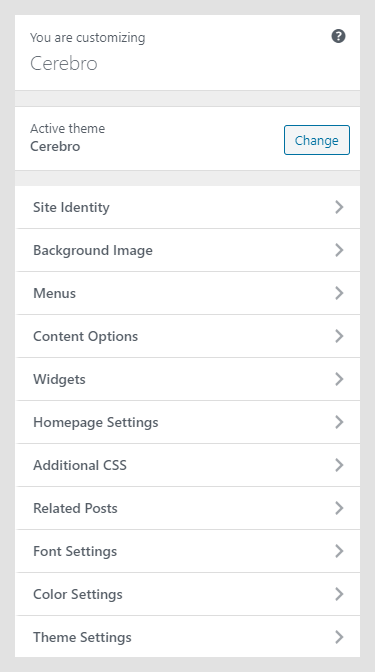
The Customizer in the Cerebro WordPress theme documentation is a great WordPress feature that allows you to customize the theme and set theme options. Theme specific settings:
- Site Identity
- Background Image
- Menus
- Content Options
- Widgets
- Homepage Settings
- Additional CSS
- Related Posts
- Font Settings
- Color Settings
- Theme Settings
Site Identity
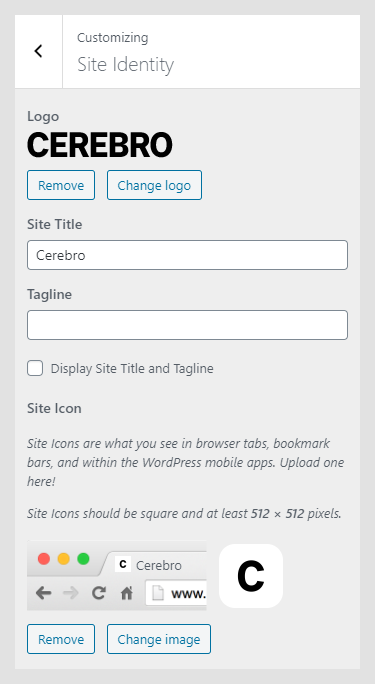
Site Identity allows you to set your site title, tagline, and icon. The Site Title is the name of your site and it’s displayed in the header, where the logo is displayed. The Tagline is a short description or your motto, and it’s displayed just under the title. This setting is the same as in Settings -> General in the WordPress admin panel.
- Logo: Upload logo for your site. The logo should be in a PNG, or JPEG/JPG format.
- Site title: Name of your site.
- Tagline: Site punchline.
- Display Site Title and Tagline: If enabled, both Site Title and Tagline will be displayed. Tagline will be displayed under the title.
- Site Icon: The Site Icon is used as a browser and app icon for your site. Icons must be square, and at least 512px wide and tall.
Background Image
Menus
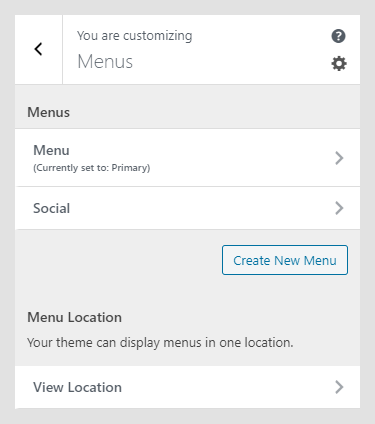
This option allows you to manage created menus quickly. You can select which created menu will be displayed as a Primary Menu. If you need to manage actual menu items, you can do that in Appearance -> Menu.
Content Options

In Content Options panel in the Cerebro WordPress theme documentation are displayed options that allow you to control post related features across the site.
- Blog Posts Content: Display post content on blog and archive pages: If this option is enabled, post content(text) will be diplayed on blog roll page and archive pages as well. If it’s disabled, only post title and featured image will be displayed.
- Posts Featured Image: Display Featured Image on Single Posts: This option controls appearance of the single post featured image. If it’s enabled, featured image from single post will be displayed both on the posts/archives pages and on the single post page.
- Author Bio: If enabled, box with post author biography will be displayed under the single post.
- Post details: Display date: If enabled, post date will be displayed on the single post page.
- Post details: Display categories: If enabled, post categories will be displayed on the single post page.
- Post details: Display tags: If enabled, post tags will be displayed on the single post page.
Widgets
The Widgets section allows you to manage widgets in widget areas quickly. This option allows you the same possibility as the Widgets option in the WordPress admin panel.
Homepage Settings

This option works the same way as Settings -> Reading. It allows you to set them to read the latest post or to use static pages for landing and blog pages.
Additional CSS
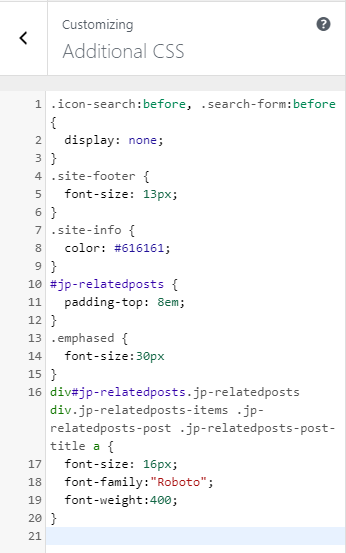
In the Additional CSS section of the Cerebro WordPress theme documentation, you can enter your custom CSS classes, so you don’t need to mess with original styles, or create a child theme. Of course, you should create a child theme if you plan to modify other files, as well.
Related Posts
Related Posts option contains options where you can control the appearance of the related posts on the single post page. You will need to open a single post page in the customizer to see these options.
Font Settings
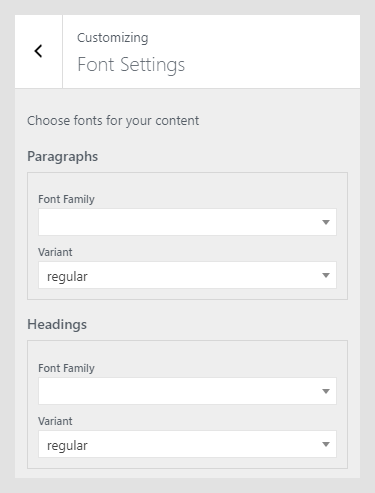
Font Settings allow you to set the font family and font-weight for headings, paragraphs and navigation. Font settings require installed and active Kirki plugin.
Color Settings

The Colors panel in the Cerebro WordPress theme documentation allows you to set the color for different elements of the theme. Available subpanels:
- General Theme Colors: Global theme color settings for background, headings, paragraphs, etc.
- Header Colors: Colors used in the theme header – header background color, navigation links and such.
- Home Slider colors: Appearance colors for the home slider.
- Footer Colors: Color for footer elements – background, links, text, etc.
Theme Settings
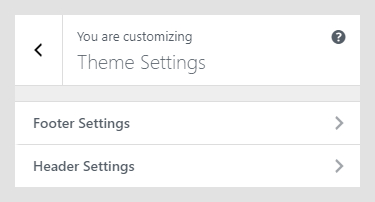
The Theme Settings panel contains theme-specific settings. Here you can customize theme appearance – featured slider, Instagram feed, footer and header settings, and to change layout appearance.
- Footer Copyright
- Header Settings
Footer Settings

Footer Settings field allows entering custom footer copyright information. If blank, default Themes Kingdom copyright will be displayed. You can use HTML to style footer content.
Header Settings
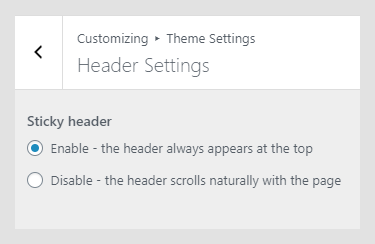
In the Header Settings panel, you can enable or disable the sticky header – if disabled, the header with navigation will scroll together with the page. The “hamburger” menu will hide navigation behind a button.
Cerebro WordPress theme documentation, step 5: Useful CSS classes
In the the Cerebro WordPress theme documentation, CSS classes can be added to Additional CSS to get a more control over styles on your site.
Increase logo
@media only screen and (min-width: 1441px) {
.site-branding {
width: 220px;
}
}
Modify main navigation font size
body .site-header .main-navigation a {
font-size: 14px;
}
</pre
Hide search
#big-search-trigger {
display: none;
}
Hide site info
.site-info {
display: none;
}
